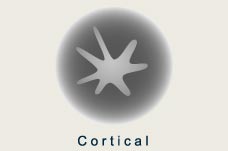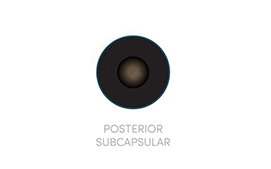Types of Cataracts

Nuclear Cataract

Cortical Cataract

Cataract surgery, also known as lens replacement surgery, is a method of removing the clouded natural lens of the eye and replacing it with an artificial lens (also known as an intraocular lens). It is performed when the natural eye lens becomes opaque and causes vision loss.
During the procedure, the ophthalmologist will remove the cataract by emulsification or by cutting the lens out. It is generally performed in local or topical anesthesia and causes little to no discomfort in the eye. Cataract surgery is performed on an outpatient basis and doesn’t require hospitalization.
A cataract forms over the eye lens, which is responsible for focusing the light that enters the eye. The lens is present behind the colored part of the eye, i.e., the iris. It produces a clear and sharp image on the retina. Due to reasons like aging, trauma, radiation exposure, etc., the mechanism of the lens may get disturbed.
The cloudiness of the lens is called a cataract which continues to develop over time, making the lens denser, thicker, and less transparent. As a result, the vision declines and becomes blurry over the years.



Both these tests are done to examine the sharpness or clarity of your vision. One eye is tested at a time to look for signs of impairment.
In this exam, a microscope is used to emit an intense line of light (slit) that illuminates the cornea, iris, lens, and the space in between. It allows the eye doctor to see the structures of the eye under magnification and detect abnormalities, including early-stage cataracts.
To perform a retinal exam, the eye doctor will firstly dilate your pupils and examine the back of the retina. This helps the doctor to identify whether the light rays are able to reach the retina or not. Generally, an ophthalmoscope is used to detect eye problems like cataracts at the early stage.
To diagnose a cataract yourself, you can try using various self-tests available on the web. These tests take only a few minutes and you’ll be able to confirm whether you have a cataract eye or not.
Besides that, you can also experience your eye lens becoming opaque and the vision declining over time. If you are aware of the symptoms of cataracts, this will also help to recognize that cataracts may be developing in one or both eyes.
If you suspect that you have a cataract, you should see an ophthalmologist. He/she will perform a comprehensive eye exam and suggest some tests.
At first, the doctor will perform a physical exam by dilating your pupil to see the internal components of the eye. If cataracts have advanced to the chronic stage, the doctor will be able to see them clearly during the physical exam. If not, then diagnostic tests will be recommended that includes:
Visual acuity and refraction test Retinal Examination Slit-lamp examination Applanation tonometry, if needed
Cataracts usually progress gradually and take years to mature. Over time, the cataract will cover more area of your natural lens as it becomes severe. The severity of cataracts are:
Early Cataracts- It is the beginning stage of cataracts at which the lens is almost clear but the ability of the lens to change focus is compromised. Due to this, symptoms like blurry vision, glare from lights, and increasing eye strain will start to appear.
Immature Cataracts- At this stage, the protein starts to accumulate on the lens, making it cloudy and slightly opaque. Along with vision problems, other symptoms like light sensitivity will also appear. You may need eyeglasses or anti-glare lenses to see nearby.
Mature Cataracts- In this stage, the cataract starts to mature, and the opacity of the lens further decreases. The lens will appear milky white or amber in color and the vision will also be considerably affected.
Hypermature Cataracts- It is the most serious stage of cataracts at which the damage to the lens is significant. If not removed at the right time, a hyper mature cataract may cause inflammation in the eye or increase the eye pressure that can cause glaucoma.
Though risks and complications are rare during cataract surgery, the cataract surgeon still looks out for risks like:
The effects of cataracts are determined by how fast it is advancing. In the beginning, cataracts will negatively impact your daily life as you won’t be able to read, work, drive, or follow any of your hobbies due to reduced vision.
Eventually, if cataracts are left untreated, they will cause total blindness that will be irreversible.
Normally, once the eye lens is replaced, there are usually no complications. Still, in rare cases, cataract surgery may fail to improve your vision. It usually happens when other underlying conditions are present, such as glaucoma or macular degeneration and they are the primary cause for eye damage.

Various studies have been done to find out if it is possible to prevent cataracts from developing or even slow their progression. Through these studies, the following things are found to be helpful in preventing cataracts to some extent:
Have regular eye examinations as they will allow you to detect cataracts as well as other eye problems at the earliest stage possible.
Quit smoking as soon as possible. Take medications, counseling, or use other strategies while you are trying to quit.
Manage other health conditions you have that can increase your risk of developing cataracts, especially diabetes.
Eat a healthy diet that consists of plenty of fruits and vegetables with antioxidants and is rich in fiber, vitamins, and minerals.
Wear sunglasses and avoid ultraviolet light exposure as much as possible as it can increase the risk of cataracts.
Avoid drinking alcohol as it can also increase the risk of cataracts.
The right time to see a cataract specialist is when you start experiencing vision loss. Blurry vision, sensitivity to light, and seeing halos are some of the first symptoms that appear in the early stages of cataracts. You should hurry up and see a doctor as soon as you notice these symptoms of cataract eye.
There are no medical or non-surgical treatments available for cataracts. The only effective treatment method is undergoing cataract surgery which involves removal of the natural lens and implanting an artificial lens in the eye.
Thus, you should consider undergoing cataract surgery as soon as possible. Normally, it is up to you to decide when to have the surgery. In most cases, there is no hurry to remove cataracts until they start affecting your daily life. However, if you have conditions like diabetes, high blood pressure, or obesity, there are chances that your cataract will progress faster.
You should know that even if you delay cataract treatment, it won’t affect how your vision improves after the surgery. Therefore, you can take time to consider the benefits and risks of the procedure and get diagnosed frequently to see how the cataract is progressing. Then the doctor will recommend when you should undergo surgery.
Cataract surgery can be performed through various techniques, such as:
Phacoemulsification
An ultrasound probe will be used to break up the lens for removal. This removal of the lens is done through phacoemulsification which involves making tiny incisions in front of the cornea.
Then the probe is inserted into the lens where the cataract has formed. The probe emits ultrasound waves to emulsify the cataract and suction out the fragments without harming other components. The backside of the lens is preserved to place the artificial lens there. After that, stitches may be used to close the cornea.
Microincision Cataract Surgery (MICS)
It is an advanced technique that involves the removal of the entire lens. In this technique, a self-sealing scleral tunnel wound is created to carry out the procedure. The size of the incision made in this type of cataract surgery is very small and the surgery is carried out with higher precision.
Extracapsular Cataract Extraction (ECCE)
It is a conventional type of cataract surgery that involves the removal of most parts of the lens except for the elastic lens capsule, also known as a posterior capsule. It is left in place so that the artificial lens can be implanted there. An incision of 10-12 mm is made in the cornea or sclera through which the procedure is carried out.
Intracapsular Cataract Extraction (ICCE)
In ICCE, the lens and lens capsule is removed completely by making a large incision. After lens removal, the artificial plastic lens is placed either in the anterior chamber or sutured in the sulcus. This type of surgery has many risks due to the large size of the incision. That is why it is rarely performed in countries where microscopes and other technologies are readily available.
Femtosecond Laser-assisted Cataract Surgery (FLACS)
It is another modern technique to perform cataract surgery where the laser is used to make an incision as well as to remove the clouded lens. It is one of the safest and most effective techniques to treat cataracts.
One of the biggest decisions that a cataract patient has to make is choosing the right intraocular lens (IOLs). There are two primary types of lenses, i.e., anterior chamber lenses and posterior chamber lenses. The anterior chamber lenses (ACIOL) are placed on top of the iris whereas posterior chamber lenses (PCIOL) are placed over the residual posterior capsule which is the original position of the lens. As compared to the ACIOLs, PCIOLs are a preferable choice as long as the posterior capsule is intact.
The various types of PCIOLs that are available in the market are:
The surgeon will discuss the specifications of these lenses and help you choose the right type of IOL for the surgery. You should also know that the cost of IOLs is not covered under health insurance policies. And the price of all these lenses varies significantly which will further increase the overall cost of cataract treatment.
The preparation for cataract surgery starts with your first consultation with the doctor. During the appointment, the eye doctor will perform the necessary tests and determine which lens implant will be the best to use during the surgery.
On the day of surgery, wear comfortable clothes and do not wear makeup, cosmetics, perfume, etc. Make sure that you arrive 30 minutes early at the hospital or clinic. Ask any questions or doubts that you have before the surgery while the surgeon prepares everything. If necessary, the surgeon will also give you a sedative to help you relax while you will stay awake during the procedure.
The surgeon will take you to the OT (operation theater) and the surgery will begin. You can expect the following things during the surgery:
The same procedure can be done using different techniques. This technique is decided after a thorough diagnosis of the eye and the test results.
*In case you experience symptoms like vision loss, persistent pain, increased redness, eyelid swelling, or light flashes in the eye, contact the eye specialist right away.
Before undergoing cataract surgery, your vision will be blurry, hazy, and clouded. But after the cataract is removed and the new artificial lens is implanted in the eye, your vision will clear up. You will notice significant changes in your vision.
The different types of cataracts that commonly develop in the eyes include:
Nuclear Cataracts-
It is a type of cataract that starts developing at the center of the lens, i.e., the nucleus. It progresses slowly and causes yellowing or browning of the lens. If you have a nuclear cataract in one or both eyes, you will at first have nearsightedness, i.e., your nearby vision will improve temporarily.
Cortical Cataracts-
A cortical cataract starts as a whitish streak that appears on the outer edge of the cortex lens. It also progresses slowly and extends to the center over time, interfering with the light that passes through the center of the lens.
Posterior Subcapsular Cataracts-
A posterior subcapsular cataract appears at the back of the lens as a small opaque area in the direct path of the light. It affects the reading vision, reduces the vision in bright light, and causes glares. It progresses quicker than other types of cataracts.
Congenital Cataracts-
It is a type of cataract that people are born with or develop during childhood due to trauma, genetics, or intrauterine infection. They usually don’t affect vision. However, if vision gets affected, you must get them removed as soon as possible.
There are other less common types of cataracts as well that include:
Yes. You will be glad to know that cataract eye surgery in India is covered under health insurance policies. As cataracts can lead to permanent blindness, which is a physical disability, its treatment is regarded as medically necessary. Thus, all insurance providers offer a specified amount of coverage for cataract treatment which may vary depending on the policy you have.
Normally, the cost of cataract surgery ranges from Rs. 35,000 to Rs. 1,00,000 approximately. This expense includes the cost of tests, doctor’s fee, OT charges, medications needed, hospital stay, etc.
If you have a health insurance policy, you can use it to cover all these expenses to the maximum. Generally, there is a waiting period of 2 years to claim the insurance against cataract treatment. Fortunately, the disease advances at a slow rate, which means you can delay getting treatment until you become eligible to get a claim for cataract surgery.
Make sure that you talk to your insurance provider and check all the terms and conditions properly to get maximum benefits.
The rate at which patients recover after having cataract surgery varies significantly. Some people are able to see clearly on the very same day whereas others may need a few days or weeks to get the results. In most cases, the complete recovery takes around a month.
First Week after Surgery -
During the first week, the eye is kept covered using an eyeglass or eyeshield to ensure that you accidentally don’t rub or poke the eye. Even the slightest amount of external pressure can reopen the incision which can lead to complications. Thus, the patient is advised to refrain from-
Bending over, i.e. taking the head below the waist
Lifting weights heavier than 10 pounds
Straining during activities, even on the toilet
If you follow these tips and use the medicines prescribed by the doctor, your recovery will be much faster and smoother.
Few Weeks after Surgery -
After a few weeks, when the vision has stabilized, the doctor will again examine your eye to see if you need eyeglasses or not. Depending on the patient’s physiology and healing abilities, full recovery may take around four to six, given the condition that you follow all the post-surgery care instructions and follow-up with the doctor at the suggested time.
Results -
The purpose of cataract surgery is to remove the clouded lens and allow the person to see clearly afterward. However, most people need glasses to see clearly (at certain distances) after cataract surgery. This is so because many people choose a monofocal lens for replacement which can only correct the vision at a single distance, either near or far.
People who’ve had cataract surgery may develop a secondary cataract, also known as posterior capsule opacification (PCO). It happens when the cataract is not removed completely and a small part of the clouded lens was left behind. As a result, the new lens implant also becomes cloudy.
The good news is that PCO can be treated with a technique YAG (yttrium-aluminum-garnet) is a painless 5-minute procedure that can clear the cloudiness on the capsule with precision. Thus, you don’t have to overstress about compromising the results of cataract surgery.
No. There is no other treatment method available for a cataract eye. It is an irreversible process that cannot be solved with the help of medications. Thus, you will need surgical treatment to cure cataracts permanently.
Yes. Cataract surgery can help to resolve refractive errors, including myopia, hyperopia, and astigmatism. In many patients who undergo cataract surgery, the treatment has helped to achieve 20/20 vision.
The ultraviolet rays of the sun can make cataracts progress faster. Food items that are rich in vitamin D can also make the cataract worse faster than normal.
Usually, 1 to 3 days of proper rest is recommended to patients who undergo cataract surgery. However, you may start feeling better quicker than usual or may need a little bit more time to rest. The doctor will look at your health and provide you an estimate of how much rest you will most likely need after cataract surgery.
Yes. You will be awake during the cataract surgery. Your eyes will be numbed with the help of topical anesthesia. So, you won’t feel anything but you will be aware of the surroundings.
No. It is almost impossible to predict how fast cataracts can grow. Most age-related cataracts progress slowly over the period of years. But there are many exceptional cases where cataracts advanced faster than predicted and caused permanent blindness in the patients.
There are minimal chances that cataracts might return even after surgical treatment. In rare cases, you may get posterior capsule opacification (PCO) which can be removed with the help of laser technique.
Eyeplus © All rights reserved | Privacy Policy